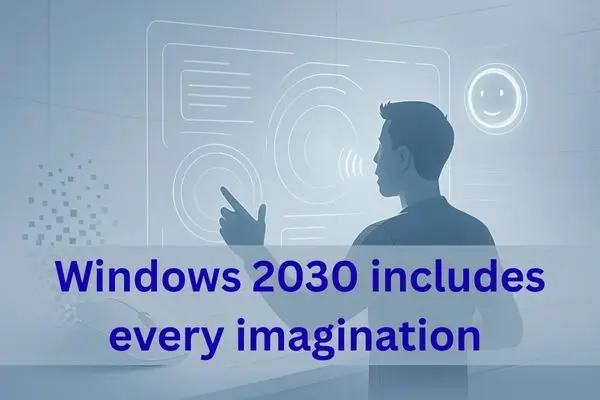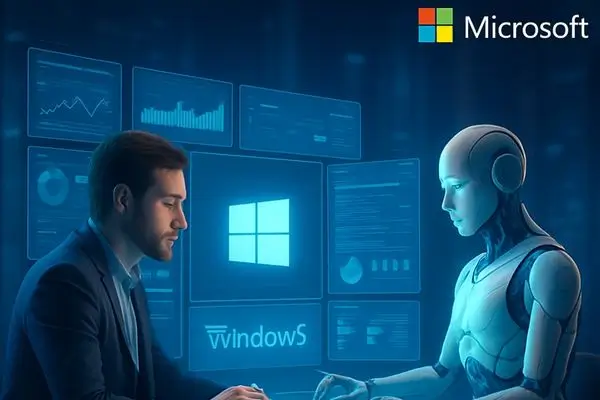Intro: A Glimpse into the Future of Computing
Microsoft is preparing for a radical transformation of how we use computers by the year 2030. The Windows 2030 Vision, recently revealed by David Weston, Vice President of OS Security at Microsoft, introduces a future where artificial Intelligence, voice interaction, and multimodal interfaces will dominate the computing landscape.
“Say goodbye to the mouse and keyboard as we know them — and hello to a world where your PC sees, hears, and speaks.” hstech.io
Topics
Table of Contents
The Era of Voice-First Computing
“2030 will be the year of AI and voice.” — David Weston (Microsoft)
The way we interact with devices is changing. Microsoft envisions a future where users will speak more and click less. This means:
- Conversational AI interfaces like Copilot, Cortana 2.0, or even your own personalized assistant.
- Systems that understand natural language commands effortlessly.
- Voice-to-action workflows are replacing traditional menus and toolbars.
Your desktop won’t just look smart—it will act smart.
See also: Top Ofice Gadgets That make you office futuristic
Computers That See and Understand
Thanks to advances in computer vision, Windows 2030 is expected to:
- Use cameras and sensors to detect gestures, facial expressions, and environmental context.
- Adjust settings based on what the user is looking at or doing.
- Enable screenless interaction, especially for AR/VR experiences.
Just like our eyes understand our surroundings, computers will be able to see, analyze, and respond in real-time.

AI at the Core of Windows
Artificial Intelligence won’t be a feature in Windows 2030 — it will be the foundation.
Expect these key enhancements:
- Predictive systems that suggest apps, automate tasks, and pre-empt user needs.
- AI-powered accessibility, making computing easier for all.
- On-device AI models allow offline smart interactions with speed and privacy.
- Cybersecurity AI agents that monitor and respond to threats autonomously.
This is the evolution from passive computing to adaptive Intelligence.
The Death of the Mouse?
One of the boldest predictions: the computer mouse may become obsolete by 2030.
Why?
- Voice commands and hand gestures will replace pointing and clicking.
- Eye-tracking technology will navigate interfaces.
- Touchless interfaces in AR/VR environments will be standard.
That means our old friend “Mr. Mouse”, as humorously noted in the Urdu commentary, may soon feel like an alien artifact in the age of AI romance.
Multimodal OS: The New Operating System Experience
Windows 2030 is expected to be multimodal, meaning:
- It combines voice, gesture, touch, and eye movement into a seamless experience.
- OS design will shift from static to adaptive, reacting to your surroundings.
- Whether you’re on a laptop, headset, or holographic display, Windows will remain synchronized and responsive.
This multimodal evolution turns Windows from a system you control into a collaborator that assists.

Impact on Productivity & Business
Businesses will benefit from:
- AI-generated reports, summaries, emails, and more.
- Smart collaboration tools that analyze meetings in real-time.
- Increased automation reduces manual effort and improves decision-making speed.
Windows 2030 aims to redefine what it means to be productive in the digital era.
What About Security?
David Weston, an expert in OS security, emphasized that AI won’t just be user-facing. It will:
- Detect security anomalies instantly.
- Create proactive defense systems against phishing, malware, and ransomware.
- Personalize authentication through biometric and behavioral recognition.
With AI, security becomes predictive and intelligent, not reactive.
Beyond the PC: Windows Everywhere
Windows 2030 isn’t just for laptops. It’s likely to power:
- Augmented reality headsets
- Home assistants
- Smart appliances
- Wearables
Microsoft’s investment in cloud computing, edge AI, and cross-device integration ensures Windows will be available anywhere you are.
Final Thoughts: Are We Ready for a Voice-AI Future?
Microsoft’s vision for 2030 is bold, immersive, and drastically different from the Windows we know. It reflects a deep shift in human-computer interaction, where computing becomes conversational, contextual, and intuitive.
So, as we move toward an AI-first world, we must ask:
Are we ready to stop clicking and start speaking?
Because the future is already listening.
See Also: Google Gemini on Wear OS 4: Best Guide to AI on Your Wrist
Pingback: 5G vs 6G Internet: The Ultimate Speed Battle, Future of Connectivity